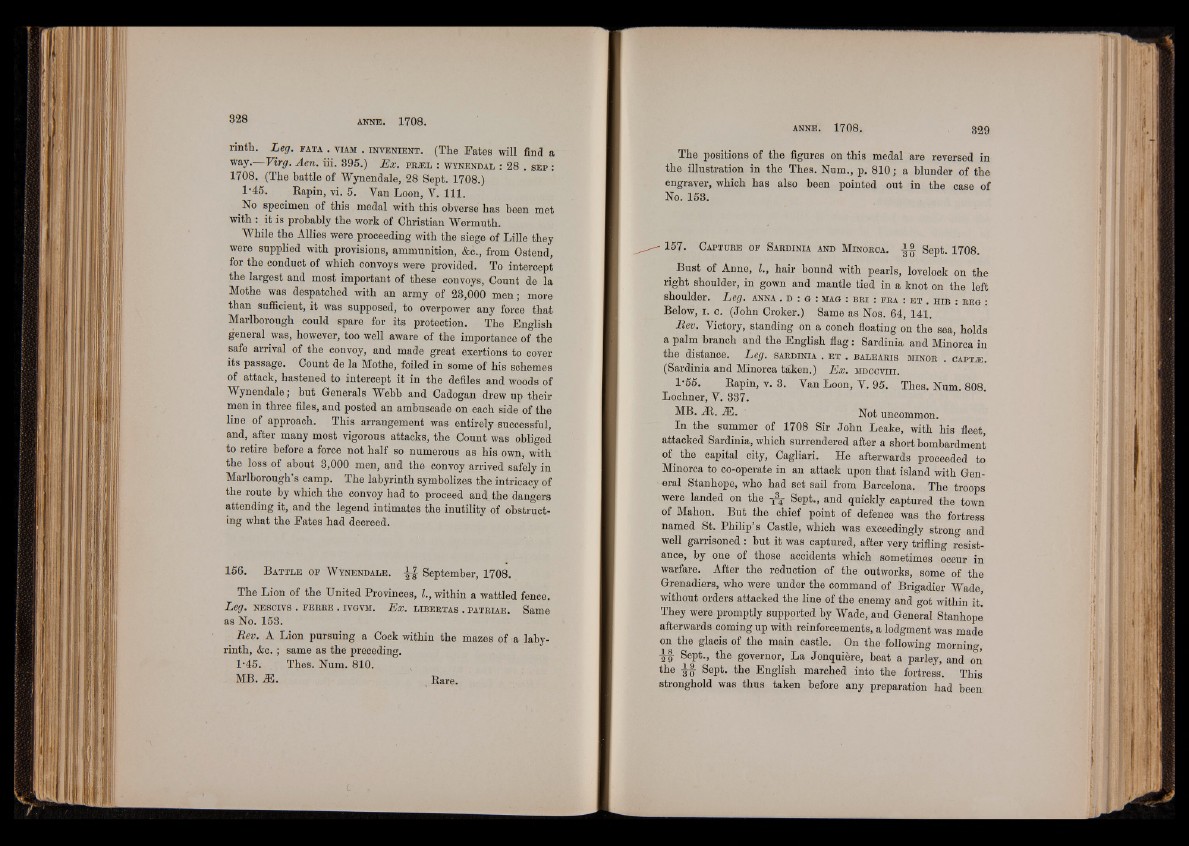
rinth. Leg. fa ta . viam . in v e n ie n t . (The Fates will find a
way.— Virg. Aen. iii. 395.) Ex. p e e l : w y n en d a l : 28 . s e p :
1708. (The battle of Wynendale, 28 Sept. 1708.)
1-45. Rapin, vi. 5. Yan Loon, V. 111.
No specimen of this medal with this obverse has been met
with : it is probably the work of Christian Wermuth.
While the Allies were proceeding with the siege of Lille they
were supplied with provisions, ammunition, &c., from Ostend,
for the conduct of which convoys were provided. To intercept
the largest and most important of these convoys, Count de la
Mothe was despatched with an army of 23,000 men; more
than sufficient, it was supposed, to overpower any force that
Marlborough could spare for its protection. The English
general was, however, too well aware of the importance of the
safe arrival of the convoy, and made great exertions to cover
its passage. Count de la Mothe, foiled in some of his schemes
of attack, hastened to intercept it in the defiles and woods of
Wynendale; but Generals Webb and Cadogan drew up their
men in three files, and posted an ambuscade on each side of the
line of approach. This arrangement was entirely successful,
and, after many most vigorous attacks, the Count was obliged
to retire before a force not half so numerous as his own, with
the loss of about 3,000 men, and the convoy arrived safely in
Marlborough’s camp. The labyrinth symbolizes the intricacy of
the route by which the convoy had to proceed and. the dangers
attending it, and the legend intimates the inutility of obstructing
what the Fates had decreed.
156. B a t t l e o f W y n e n d a l e . September, 1708.
The Lion of the United Provinces, I., within a wattled fence.
Leg. n e s c i v s . f e e k e . iv g vm . E x . l i b e b t a s . p a t e i a e . Same
as No. 153.
Rev. A Lion pursuing a Cock within the mazes of a labyrinth,
&c.; same as the preceding.
l -45. Thes. Num. 810.
MB. IE. Rare.
The positions of the figures on this medal are reversed in
the illustration in the Thes. Num., p. 810 ; a blunder of the
engraver, which has also been pointed out in the case of
No. 153.
157. C a p t u b e o f S aedinxa and M in o e c a . -W Sept. 1708.
Bust of Anne, I., hair bound with pearls, lovelock on the
right shoulder, in gown and mantle tied in a knot on the left
shouldei. Leg. anna . d i g : mag * bbi ; fba : e t . hib : beg :
Below, i. c. (John Croker.) Same as Nos. 64, 141.
Rev. Victory, standing on a conch floating on the sea, holds
a palm branch and the English flag: Sardinia and Minorca in
the distance. Leg. sa b d in ia . e t . b a l e a b is m in o b . c a p t js .
(Sardinia and Minorca taken.) Ex. m d c c v iii.
1-55. Rapin, v. 3. Yan Loon, V. 95. Thes. Num. 808.
Lochner, Y. 337.
MB. At. IE. ' Not uncommon.
In the summer of 1708 Sir John Leake, with his fleet,
attacked Sardinia, which surrendered after a short bombardment
of the capital city, Cagliari. He afterwards proceeded to
Minorca to co-operate in an attack upon that island with General
Stanhope, who had set sail from Barcelona. The troops
were landed on the Sept., and quickly captured the town
of Mahon. But the chief point of defence was the fortress
named St. Philip’s Castle, which was exceedingly strong and
well garrisoned : hut it was captured, after very trifling resistance,
by one of those accidents which sometimes occur in
warfare. After the reduction of the outworks, some of the
Grenadiers, who were under the command of Brigadier Wade
without orders attacked the line of the enemy and got within it.
They were promptly supported by Wade, and General Stanhope
afterwards coming up with reinforcements, a lodgment was made
on the glacis of the main castle. On the following morning,
-|-§- Sept., the governor, La Jonquiere, beat a parley, and on
the -§-§ Sept. the English marched into the fortress. This
stronghold was thus taken before any preparation had been